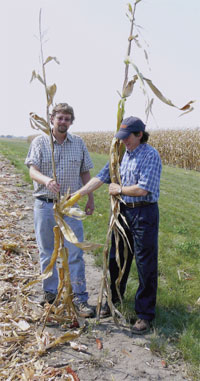Urbana, Illinois
October 16, 2007
 |
|
U of I doctoral student Mike Vincent, left,
holds a stalk of regular hybrid corn and
compares it to a stalk of tropical maize held by
U of I Professor of Plant Physiology Fred Below.
Tropical maize can easily grow to 14 or 15 feet
tall, compared to the 7-1/2 feet that are
average for conventional Midwest corn |
|
When
University of Illinois crop scientist Fred Below began
growing tropical maize, the form of corn grown in the tropics,
he was looking for novel genes for the utilization of nitrogen
fertilizer and was hoping to discover information that could be
useful to American corn producers.
Now, however, it appears that maize itself may prove to be the
ultimate U.S. biofuels crop. Early research results show that
tropical maize, when grown in the Midwest, requires few crop
inputs such as nitrogen fertilizer, chiefly because it does not
produce any ears. It also is easier for farmers to integrate
into their current operations than some other dedicated energy
crops because it can be easily rotated with corn or soybeans,
and can be planted, cultivated and harvested with the same
equipment U.S. farmers already have. Finally, tropical maize
stalks are believed to require less processing than corn grain,
corn stover, switchgrass, Miscanthus giganteus and the scores of
other plants now being studied for biofuel production.
What it does produce, straight from the field with no
processing, is 25 percent or more sugar in the forms of sucrose,
fructose and glucose.
"Corn is a short-day plant, so when we grow tropical maize here
in the Midwest the long summer days delay flowering, which
causes the plant to grow very tall and produce few or no ears,"
says Below. Without ears, these plants concentrate sugars in
their stalks, he adds. Those sugars could have a dramatic affect
on Midwestern production of ethanol and other biofuels.
According to Below, “Midwestern-grown tropical maize easily
grows 14 or 15 feet tall compared to the 7-1/2 feet height that
is average for conventional hybrid corn. It’s all in these tall
stalks." Below explains. "In our early trials, we are finding
that these plants build up to a level of 25 percent or higher of
sugar in their stalks.
This differs from conventional corn and other crops being grown
for biofuels in that the starch found in corn grain and the
cellulose in switchgrass, corn stover and other biofuel crops
must be treated with enzymes to convert them into sugars that
can be then fermented into alcohols such as ethanol.
Storing simple sugars also is more cost-effective for the plant,
because it takes a lot of energy to make the complex starches,
proteins, and oils present in corn grain. This energy savings
per plant could result in more total energy per acre with
topical maize, since it produces no grain.
"In terms of biofuel production, tropical maize could be
considered the 'Sugarcane of the Midwest,'" Below said. "The
tropical maize we’re growing here at the University of Illinois
is very lush, very tall, and very full of sugar." He added that
his early trials also show that tropical maize requires much
less nitrogen fertilizer than conventional corn, and that the
stalks actually accumulate more sugar when less nitrogen is
available. Nitrogen fertilizer is one of major costs of growing
corn.
He explained that sugarcane used in Brazil to make ethanol is
desirable for the same reason: it produces lots of sugar without
a high requirement for nitrogen fertilizer, and this sugar can
be fermented to alcohol without the middle steps required by
high-starch and cellulosic crops. But sugarcane can’t be grown
in the Midwest.
The tall stalks of tropical maize are so full of sugar that
producers growing it for biofuel production will be able to
supply a raw material at least one step closer to being turned
into fuel than are ears of corn.
"And growing tropical maize doesn’t break the farmers’ rotation.
You can grow tropical maize for one year and then go back to
conventional corn or soybeans in subsequent years," Below said.
"Miscanthus, on the other hand, is thought to need a three-year
growth cycle between initial planting and harvest and then your
land is in Miscanthus. To return to planting corn or soybean
necessitates removing the Miscanthus rhizomes.
Below is studying topical maize along with doctoral candidate
Mike Vincent and postdoctoral research associate Matias Ruffo,
and in conjunction with U of I Associate Professor Stephen
Moose. This latest discovery of high sugar yields from tropical
maize became apparent through cooperative work between Below and
Moose to characterize genetic variation in response to nitrogen
fertilizers.
Currently supported by the National Science Foundation, these
studies are a key element to developing maize hybrids with
improved nitrogen use efficiency. Both Below and Moose are
members of Illinois Maize Breeding and Genetics Laboratory
(http://imbgl.cropsci.uiuc.edu/tradition.html), which has a long
history of conducting research that identifies new uses for the
maize crop.
Moose now directs the longest-running plant genetics experiment
in the world, in which more than a century of selective breeding
has been applied to alter carbon and nitrogen accumulation in
the maize plant. Continued collaboration between Below and Moose
will investigate whether materials from these long term
selection experiments will further enhance sugar yields from
tropical maize. |
|